
Utility in Complex Synthesis
Synthesis of longer and complex peptides is a challenging task due to aggregation of the growing peptide chain caused by the intrinsic intramolecular hydrogen bonds. These result in slower and incomplete coupling reaction, and in incomplete deprotection of the Na-amino protecting group. Advances in peptide synthesis methods and ready availability of reagents that disrupt these inherent intramolecular hydrogen bonds have now made such complex syntheses facile.
There are three strategies for disrupting aggregation depending on the type of building block used and are described here. The first and most prevalent strategy employs Fmoc-pseudoproline dipeptides for incorporating the serine/ threonine and the residue succeeding it. The second strategy exploits the unique benefits of Fmoc-isoacyl dipeptides, and the third strategy uses Fmoc- (Dmb)amino acids and dipeptides.
I. Utility of Fmoc-pseudoproline dipeptides refs 1-5:
This is the most common approach for disrupting aggregation. The position of “Serine” or “Threonine” in the sequence of peptide is identified. Instead of coupling the “Serine” as a single residue (Fmoc-Ser-OH), the dipeptide sequence that includes the next amino acid (Xxx) in the sequence after serine/ threonine is coupled as Fmoc- Xxx-Ser/Thr-OH pseudoproline dipeptide. Peptides containing >120 amino acids have now been made using this approach!
The following benefits of using pseudoproline dipeptides in peptide synthesis are well established:
- Insertion of “just one Fmoc-pseudoproline dipeptide” has been shown to exert a beneficial (telescopic) effect of making the coupling of the next six amino acid residues facile!
- The “Dimethyloxazolidine Bridge” serves as a semi-permanent protecting group for the hydroxyl of “Serine or Threonine”. Thus, protected peptide segments made using 2-Chlorotrityl resins that have C-terminal pseudoproline can be coupled to other segments virtually free of epimerization. This has expanded the segment condensation synthetic arsenal. Previously only segments with C-terminal “Glycine” or “Proline” were amenable for segment condensation.
- The yield and quality of cyclic peptides is improved when the sequence contains the “intact pseudoproline”.
- The “Dimethyloxazolidine Bridge” is cleaved during the final “Trifluoroacetic Acid (TFA)” treatment to regenerate “Serine or Threonine”. Highly hydrophobic aggregating native sequences produced using this strategy will still be difficult to purify by reversed phase HPLC because of the loss of the de-aggregation benefit once the pseudoproline moiety is cleaved. In such instances, the use of isoacyl dipeptide strategy is recommended (see below) because the de-aggregation benefit extends to purification as well.
II. Utility of Fmoc-isoacyl dipeptides ref 6:
These are proving to be remarkable tools for enhancing the synthetic efficiency in the Fmoc/ tbutyl based solid phase strategy. Substitution of Xxx-Ser/Thr in a peptide sequence with the corresponding isoacyl dipeptide results in the formation of a depsipeptide analog of the native sequence. Here an ester linkage replaces the original amide bond between Xxx and Ser or Thr. This modification results in a marked change in the conformation of the peptide chain. The result is disruption of aggregation in a manner similar to the effect seen with the pseudoproline or N-Dmb/Hmb-residue. The added benefit due to the survival of the depsipeptide bond after the final TFA cleavage step is “de-aggregation” of the natural aggregating peptide, and hence the resultant beneficial impact on purification. The native peptide is regenerated when exposed to basic pH.
III. Utility of Fmoc-(Dmb)Gly-OH and analogs refs 7-8:
The deaggregation benefits of N-alkyl amino acids are seen with (Dmb)Gly and with the corresponding dipeptide analogs. The use of Fmoc- Asp(OtBu)-(Dmb)Gly-OH in sequences containing –Asp-Gly- has been shown to suppress formation of b-Aspartyl peptides. The beneficial use of Fmoc-Gly-(Dmb)Gly-OH in the synthesis of peptides containing multiple glycines has been demonstrated.
Selected References:
- Mutter et al., Pept. Res 8, 145 (1995).
- Haack, T. and M. Mutter, Tetrahedron Lett., 33, 1589 (1992).
- White et al., J. Pept. Sci., 10, 18 (2004)
- Wöhr & M. Mutter, J. Am. Chem. Soc., 118, 9218 (1996)
- Skropeta et al., J. Org. Chem., 69, 8804 (2004)
- Yoshiya et al., Org. Biomol. Chem., 5, 1720 (2007)
- Zahariev, et al., J. Pept. Sci., 11, 17 (2005)
- Cardona et al., Int. J. Pept. Res. Ther., 14, 285 (2008)









